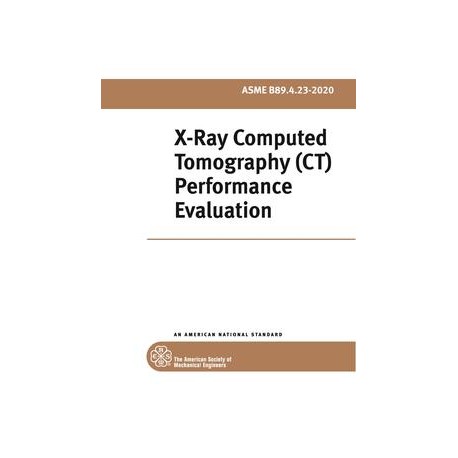Cart
0
Product
Products
(empty)
No products
To be determined
Shipping
$0.00
Total
Product successfully added to your shopping cart
Quantity
Total
There are 0 items in your cart.
There is 1 item in your cart.
Total products
Total shipping
To be determined
Total
Reduced price!
 View larger
View larger
 View larger
View larger
ASME B89.4.23-2020
M00000041
New product
ASME B89.4.23-2020 X-Ray Computed Tomography (CT) Performance Evaluation
standard by ASME International, 11/30/2020
In stock
More info
Full Description
This Standard specifies the dimensional measurement accuracy of industrial X-ray computed tomography (CT) systems for length, size, and form measurands of sphere-based test objects made of homogeneous materials. Medical CT systems are outside the scope of this Standard. The material properties of the measured test objects are restricted to three classes of material selected to be representative of industrial materials: plastic polymers, aluminum alloys, and steel alloys; other materials are outside the scope of this Standard. However, this Standard may be used as a guide for testing the performance of a CT system for other materials. The evaluation of workpieces composed of multiple materials or of materials with density gradients, i.e., gradual density variations within the material, is outside the scope of this Standard.This Standard is applicable to dimensional measurements made at the surface of the workpiece, i.e., at the workpiece materialair interface, including those of internal cavities. The effect of complex workpiece-material influence is simulated by test objects composed of spheres (serving as the metrological geometric elements) and an obstructing body; the obstructing body's dimensions are uncalibrated and its shape may be arbitrary. The spheres and obstructing body shall be of the same class of material and their combined length shall not exceed the maximum penetration length for this class of material, as stated by the CT system manufacturer.
This Standard applies to a variety of CT systems that may vary by scanning mode and system components involved in the acquisition of images. In cases where a system provides multiple configurations of X-ray sources, detectors, and scanning modes, the dimensional measurement accuracy may be specified for each scanning mode.
This Standard does not mandate testing (by either the CT manufacturer or the user) to verify CT performance. The amount of testing, and which party will bear the cost of testing, is a business decision and must be negotiated between the two parties. Calibrated test objects can be expensive; hence, the parties should recognize the costs involved and plan the testing accordingly.
Due to contrast sensitivity issues that can arise when X-rays must penetrate through large amounts of material, this Standard does not provide maximum permissible error specifications that apply to detecting high spatial-frequency form errors.

